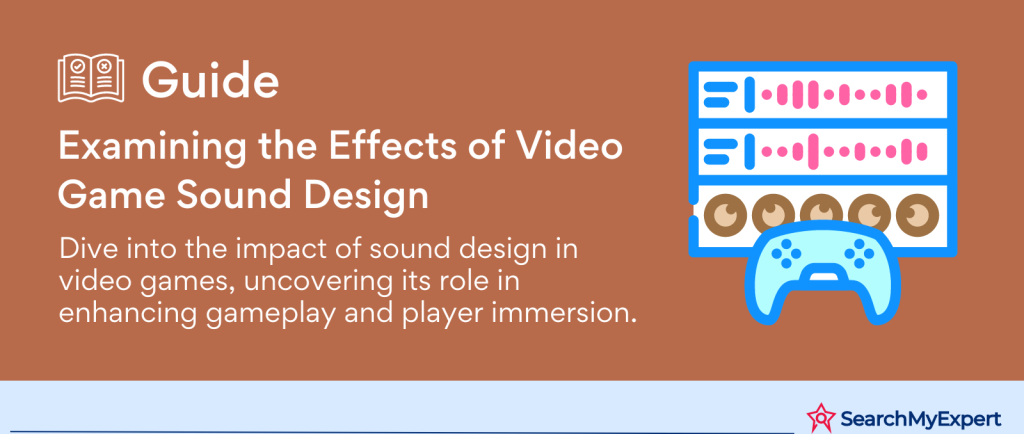The Power of Sound: Elevating the Gaming Experience
In the intricate tapestry of video game development, the sound design stands as a pivotal element, often operating quietly in the background yet significantly shaping the player’s experience. This introduction aims to unfold the layers of sound design in video games, highlighting its indispensable role in crafting immersive, engaging experiences.
Understanding Sound Design in Video Games
Sound design in gaming is the art of creating and integrating audio elements to build a convincing and interactive game environment. This encompasses everything from ambient sounds and character dialogues to sound effects and musical scores. Each auditory component is crucial in bringing the virtual world to life, making it as immersive as the visual elements. Think of sound design as the heartbeat of a game – it gives rhythm and emotion to the player’s journey, making the experience feel complete and alive.
The Role of Sound in Immersive Gaming
The immersive power of sound in video games cannot be overstated. It’s not just about hearing; it’s about feeling. When a player navigates through different environments, the change in soundscapes—from the bustling streets of a city to the tranquil sounds of nature—deepens their immersion into the game’s world. Sound cues such as footsteps, environmental noises, and character interactions add layers of realism, making the virtual environment more tangible and believable. The right sound at the right moment can transform a simple gaming session into an enthralling adventure.
Sound Design as a Storytelling Tool
Beyond immersion, sound design is a potent storytelling tool. It can set the mood, build tension, and evoke emotions without a single word being spoken. For instance, a slow, melancholic melody can signify sadness or loss, while rapid, dissonant tones can create a sense of danger or urgency. Sound design can also be used to foreshadow events, guide players through gameplay, and enhance narrative arcs, making it an integral part of the storytelling process.
Impact of Sound on Emotional Response
The emotional impact of sound design in video games is profound. The right combination of music and sound effects can elicit a wide range of emotions—from joy and excitement to fear and sadness. This emotional connection is what makes players invested in the game, transforming a recreational activity into a deeply personal experience. The emotional resonance of sound can make certain game moments memorable, leaving a lasting impression on the player.
Sound Design: The Unseen Character
In many ways, sound design acts as an unseen character in video games, influencing the player’s perception and interaction with the game world. It plays a critical role in character development and world-building, providing context and depth to the on-screen action. Sound design can even compensate for visual limitations, using audio cues to convey information that might not be visually apparent.
Decoding the Elements of Sound Design in Video Games
Sound design in video games is a complex and creative process, involving various components that work in harmony to create an immersive auditory experience. This section delves into these key elements: sound effects, music, voice acting, and audio positioning. Each plays a distinct role in enhancing the game’s environment, narrative, and overall player engagement.
Sound Effects: The Building Blocks of Game Audio
Sound effects are the backbone of sound design in video games. They encompass a wide range of sounds from the subtle rustling of leaves to the dramatic impact of explosions. These effects are crucial for creating a realistic and engaging game world.
- Environmental Sounds:
These sounds form the ambient background of the game’s world, like the chirping of birds, the rustling of trees, or the hustle of a city. They set the scene and provide a sense of place, making the game world feel alive and dynamic. - Action Sounds:
These include the sounds of character actions such as footsteps, weapon handling, or the rustling of clothing. They are synchronized with the player’s actions, providing immediate feedback and enhancing the sense of control and immersion. - Event Sounds:
These are triggered by specific events in the game, like gunfire, explosions, or the sound of a door creaking open. They often carry significant narrative weight, signaling danger, success, or other key game developments.
Music: Setting the Tone and Mood
Music in video games is more than just a soundtrack; it’s an emotional guide that enhances the gaming experience. It ranges from subtle background scores to dynamic, thematic melodies that adapt to the gameplay.
- Background Scores:
These are continuous musical pieces that play in the background, setting the overall tone and mood of the game. They are often used to complement the game’s setting, whether it’s a peaceful village or a tense battlefield. - Thematic Melodies:
These are specific tunes associated with characters, locations, or significant plot points. They help in creating memorable and emotionally resonant moments, reinforcing the narrative and character connections. - Dynamic Soundtracks:
These innovative soundtracks change based on the player’s actions or game events. For instance, the music may intensify during combat or quiet down during exploration, dynamically aligning with the gameplay.
Voice Acting: Bringing Characters to Life
Voice acting is a critical component of sound design, providing depth and personality to the game’s characters. It includes all spoken elements in the game, from main character dialogues to ambient chatter.
- Character Dialogue:
This forms the bulk of voice acting, where actors lend their voices to the game’s characters. Good voice acting can enhance character development, convey emotions, and drive the narrative forward. - Narration:
Some games feature a narrator who guides the player through the story or provides background information. This narration can add a unique flavor to the game and help in storytelling. - Ambient Chatter: This includes background conversations and noises made by non-playable characters (NPCs) in the game world. It adds to the realism and depth of the game’s environment.
Audio Positioning: Crafting a 3D Soundscape
Audio positioning, or spatial audio, is a technique used to create a three-dimensional sound experience. This aspect of sound design plays a crucial role in enhancing realism and directionality in games.
- 3D Audio:
This technology simulates the way sounds are heard in the real world, taking into account distance, direction, and the environment. It helps players locate sounds in a three-dimensional space, adding a layer of realism to the game. - Spatializing Sound: This involves placing sounds in specific locations in the game world, so they appear to come from a particular direction or distance. This is especially important in games where player orientation and situational awareness are key.
The Art of Immersive Soundscapes in Video Games
Sound design in video games is not just an auditory feature; it’s a crucial tool in world-building. By crafting detailed soundscapes, game developers can create more immersive, believable environments that enhance the player’s experience. This section explores how sound design contributes to world-building, focusing on creating believable environments, reinforcing game themes and genres, and providing critical cues and information to players.
Creating Believable Environments and Atmospheres
The foundation of an immersive gaming experience is the believability of its environment, and sound design is key to achieving this.
- Ambient Sounds:
These are the sounds that define an environment. In a forest, for instance, the sound of wind rustling through leaves, distant animal calls, and the crunch of underbrush underfoot can transport players into that setting. Each environment in a game has its unique sound profile, which helps in creating a sense of place. - Contextual Audio:
Sound design also adapts to the context within the game. For example, the echo in a large cave or the muffled sounds in a snowstorm not only add to the realism but also enhance the player’s sense of presence in these environments. - Interactive Sounds:
Sounds that respond to the player’s actions, like footsteps changing from a splash in puddles to a clatter on cobblestones, increase the realism of the game world. This interactivity makes the environment feel more tangible and responsive.
Reinforcing the Game’s Theme and Genre
Sound design plays a pivotal role in reinforcing a game’s theme and genre, shaping the player’s perception and overall experience.
- Genre-specific Sounds: Every game genre has its characteristic sounds. Horror games, for example, often use dissonant music and eerie sound effects to create a tense atmosphere, while fantasy games might use ethereal melodies and magical sound effects to evoke a sense of wonder.
- Thematic Consistency:
Consistency in sound design helps in maintaining the game’s thematic integrity. For instance, a game set in a futuristic world might use synthetic sounds and electronic music, aligning the audio with the visual elements of the game. - Mood Setting: The right sound can set the mood for different parts of the game. A triumphant musical score during a victory scene or a somber tune during a loss can significantly amplify the thematic impact of these moments.
Providing Cues and Information to Players
Sound design is not just for ambiance; it’s a vital tool for conveying information and cues to the player, enhancing gameplay and strategy.
- Directional Cues: Sounds can inform players about the direction of threats or objectives. For instance, the sound of an enemy’s footsteps growing louder can alert players to their approach.
- Environmental Clues:
Sounds can also hint at environmental interactions or hidden secrets. A subtle sound might indicate the presence of a hidden door or an item, guiding players to explore and discover. - Feedback for Actions:
Audio feedback for player actions, like the sound of a successful hit or a door unlocking, provides immediate and intuitive information, making the gameplay experience more satisfying and informative.
How Sound Design Amplifies Storytelling in Video Games
The sound design in video games does more than just provide an auditory background; it plays a crucial role in storytelling, enhancing the narrative impact and emotional depth of the gaming experience. This section explores how sound design contributes to storytelling by eliciting specific emotions from players, underscoring dramatic moments, and enhancing dialogue and voice-acting performances.
Eliciting Specific Emotions and Reactions from Players
Sound design is a powerful tool in the emotional toolkit of a video game, capable of evoking a wide range of responses from players.
- Emotional Soundtracks:
Music is one of the most direct ways sound design can influence emotions. A melancholy tune can evoke sadness, while an upbeat rhythm can bring about excitement. Game composers use various musical techniques to mirror and amplify the emotional content of a game’s narrative. - Sound Effects and Mood:
The use of sound effects also plays a significant role in shaping the player’s emotional response. The crash of thunder in a stormy scene or the unsettling creak of a door in a horror game can heighten feelings of fear or suspense. - Ambient Sounds and Atmosphere: Even ambient sounds contribute to the emotional tone of a game. The peaceful chirping of birds in a serene landscape can instill calm, while the oppressive sounds of machinery in a dystopian setting can create a sense of dread.
Underscoring Dramatic Moments and Character Development
Sound design plays a pivotal role in highlighting key moments in a game’s narrative and the development of its characters.
- Highlighting Key Narrative Moments:
Sound cues are often used to draw attention to important events. A sudden shift in music or a dramatic sound effect can signal a plot twist, a revelation, or a climactic battle, enhancing the impact of these moments. - Character Themes and Development: Characters may have their own thematic motifs or leitmotifs that play when they appear or during significant character moments. These musical cues can reflect a character’s personality, evolution, and their relationship to the story.
- Environmental Storytelling: Sound can also be used to tell a story within the environment itself. The echoes in an abandoned hall, the distant sounds of battle, or the hustle and bustle of a busy marketplace can all provide context and background to the game’s narrative.
Enhancing Dialogue and Voice Acting Performances
The integration of sound with dialogue and voice acting is crucial in bringing depth and realism to the characters and story.
- Voice Acting and Emotional Weight:
Good voice acting can convey a range of emotions and motivations, making characters more relatable and the narrative more engaging. The quality of sound recording and mixing plays a significant role in ensuring that voice performances are clear and impactful. - Dialogue Enhancement: Sound effects can be used to enhance dialogue scenes. Background noises, like the clink of glasses in a tavern or the hum of engines on a spaceship, can add realism and depth to dialogue exchanges.
- Non-verbal Vocal Sounds:
Non-verbal vocal sounds such as grunts, sighs, or laughter can add layers to a character’s portrayal, providing nuance and depth beyond the script. These sounds can convey emotions and reactions that dialogue alone might not fully express.
The Strategic Use of Silence in Video Game Sound Design
In the dynamic world of video game sound design, silence is not merely the absence of sound, but a powerful tool in its own right. Thoughtfully employed, silence can be as impactful as the most elaborate sound effects or the grandest musical score. This section explores the deliberate use of silence in sound design, focusing on its ability to build tension and anticipation, amplify the impact of other sound elements, and create moments of reflection and immersion.
Building Tension and Anticipation
Silence can be a potent element in crafting suspenseful and tense moments in video games.
- The Contrast of Silence and Sound: In the midst of a bustling soundscape, a sudden plunge into silence can be jarring and unsettling. This sharp contrast can heighten the player’s sense of unease and expectation, as they anticipate what might break the silence.
- Silence as a Premonition:
In many games, especially those in the horror or suspense genre, silence is often used as a prelude to a significant or frightening event. The absence of sound primes players to be on high alert, making the eventual break of silence – often with a startling sound effect – even more impactful. - Creating Suspenseful Gameplay Dynamics:
In stealth-based games, moments of silence can create a sense of suspense and tension. The quietness can make players more aware of their actions and surroundings, as they navigate through potentially perilous situations.
Amplifying the Impact of Sound Effects and Music
Silence can enhance the emotional and dramatic impact of sound effects and music when they do occur.
- Highlighting Key Sound Elements:
By preceding a key sound effect or piece of music with silence, designers can ensure that these elements stand out. This can be particularly effective for critical narrative moments or significant gameplay events. - Dramatic Pacing with Silence: Strategically placed silence can be used to pace the dramatic flow of a game. It can provide a brief respite or a moment of suspense before a significant change in the game’s sound environment, enhancing the overall impact of the audio experience.
- Enhancing Emotional Resonance: Music or sound effects that emerge from a silent backdrop can carry a heightened emotional weight. This can be particularly powerful in moments of triumph, revelation, or loss within the game’s narrative.
Creating Moments of Reflection and Immersion
Silence can also be used to create spaces for reflection, allowing players to immerse themselves deeper into the game’s world and narrative.
- Facilitating Player Reflection:
Periods of silence can give players a moment to reflect on the story or the events that have just unfolded. This can be particularly effective after emotionally charged or action-packed sequences. - Immersion in the Game World:
In some games, especially those emphasizing exploration and contemplation, periods of silence can encourage players to focus more on the visual elements of the game, fostering a deeper sense of immersion and connection to the game world. - Silence as a Narrative Tool:
In storytelling, silence can be used to signify significance, loss, or contemplation. It allows players to absorb and process the narrative events, adding depth and meaning to the gaming experience.
The Future of Game Audio in the Digital Age
The landscape of game audio is continuously evolving, driven by technological advancements and creative innovations. Emerging trends in game audio are not only enhancing the player experience but also redefining the boundaries of what’s possible in sound design. This section explores the forefront of these advancements, focusing on AI-powered sound generation, the integration of haptic feedback and spatial audio, and the role of audio in VR/AR environments.
AI-Powered Sound Generation and Personalization
Artificial Intelligence (AI) is revolutionizing game audio by introducing new capabilities for sound generation and personalization.
- Dynamic Sound Generation: AI technologies enable the creation of dynamic, procedurally generated soundscapes that can adapt to gameplay in real time. This means that sound effects and ambient noises can change based on player actions, time of day in the game, or specific game events, creating a more responsive and varied audio experience.
- Personalized Audio Experiences: AI algorithms can analyze player behavior and preferences to tailor the game’s audio to individual players. This could lead to personalized soundtracks and sound effects that adapt to each player’s style, enhancing their immersion and engagement.
- Voice Synthesis and Processing: AI-driven voice synthesis is becoming increasingly sophisticated, allowing for more realistic and varied character voices. This technology can also be used for real-time voice processing and modulation, adding depth and diversity to voice acting in games.
Haptic Feedback and Spatial Audio Technologies
The integration of haptic feedback and spatial audio enhances the sensory richness of game audio.
- Haptic Audio Feedback: Haptic technology, which creates tactile sensations, is being combined with audio to provide a more immersive experience. This means players can not only hear sound effects but also feel them, such as the vibration of an explosion or the rumble of an engine.
- Advancements in Spatial Audio: Spatial audio technology, like Dolby Atmos or Sony’s Tempest 3D AudioTech, is becoming more prevalent in gaming. These technologies allow for more precise and immersive sound positioning, giving players a more realistic sense of space and direction in the game environment.
- Cross-Device Compatibility:
As spatial audio and haptic feedback technologies advance, there is also a trend towards cross-device compatibility, ensuring that players have a consistent and immersive audio experience across various gaming platforms and devices.
VR/AR Applications and Immersive Soundscapes
Virtual Reality (VR) and Augmented Reality (AR) gaming are pushing the boundaries of immersive soundscapes.
- Enhanced Immersion in VR/AR:
In VR and AR environments, audio plays a critical role in creating a sense of presence. Advanced 3D audio techniques are used to craft soundscapes that accurately mimic how sound behaves in the real world, enhancing the overall sense of immersion. - Interactive Audio Environments:
VR/AR allows for more interactive audio experiences. Sound can change based on the player’s movements and interactions within the virtual environment, creating a dynamic and responsive audio landscape. - Integration of Real and Virtual Audio:
In AR gaming, there’s a growing trend toward integrating real-world sounds with virtual audio elements. This blend of real and virtual soundscapes creates a unique and immersive experience that enhances the player’s engagement with both the game and their physical environment.
Harmonizing the Past, Present, and Future: The Crescendo of Game Audio Design
As we conclude our exploration of sound design in video games, it is essential to encapsulate the journey from the basic elements of game audio to the cutting-edge advancements shaping its future. This final section serves to summarize the key points discussed, reiterate the vital role of sound design in engaging players, and ponder on the future trajectory of game audio.
The Quintessence of Sound Design in Video Games
The sound design in video games has evolved from a mere background element to a sophisticated, multifaceted component integral to the gaming experience.
- Creating Immersive Worlds:
We discussed how sound effects, from environmental sounds to character actions, play a crucial role in crafting immersive and believable game worlds. - Emotional Storytelling: Music and sound design are powerful tools in evoking emotions and enhancing storytelling, guiding players through a spectrum of experiences from joy to fear.
- Strategic Silence:
The use of silence in sound design adds depth and tension, providing a contrast that can heighten the impact of sound and music.
The Impact of Sound Design on Player Engagement
The importance of sound design in engaging players and creating memorable experiences cannot be overstated.
- Enhancing Gameplay: Sound provides critical gameplay cues, from the footsteps of an approaching enemy to the sound of a hidden treasure, enhancing both the challenge and enjoyment of the game.
- Building Connections: Through character voices and thematic music, sound design establishes emotional connections between the player and the game, making experiences more personal and impactful.
- Sensory Immersion:
Advanced audio techniques, including 3D audio and haptic feedback, are creating more immersive and interactive gaming experiences, engaging players on multiple sensory levels.
Contemplating the Future of Game Audio
As we look towards the future, the evolving landscape of game audio holds limitless potential.
- Technological Advancements: The integration of AI in sound design, advancements in spatial audio, and the growth of VR/AR gaming are pushing the boundaries of what is possible in game audio.
- Personalization and Interactivity: Future developments may lead to more personalized audio experiences, where sound adapts to individual player preferences and actions, creating unique gaming experiences for each player.
- The Uncharted Territory: The ongoing innovations in-game audio raise intriguing questions about the future of sound design. How will emerging technologies further transform the gaming experience? Will the line between game audio and reality continue to blur, and what new immersive experiences will this create?
Conclusion
The journey of sound design in video games is one of continuous innovation and creativity. From enhancing the immersive quality of game worlds to emotionally engaging players, sound design has proven to be an indispensable aspect of video game creation. As we contemplate the future, one thing is certain: the evolution of game audio will continue to play a critical role in shaping the gaming experiences of tomorrow, creating new realms of possibility in the digital storytelling landscape.
Innovate and inspire with
Game Development Firms.
Table of Contents
Toggle






